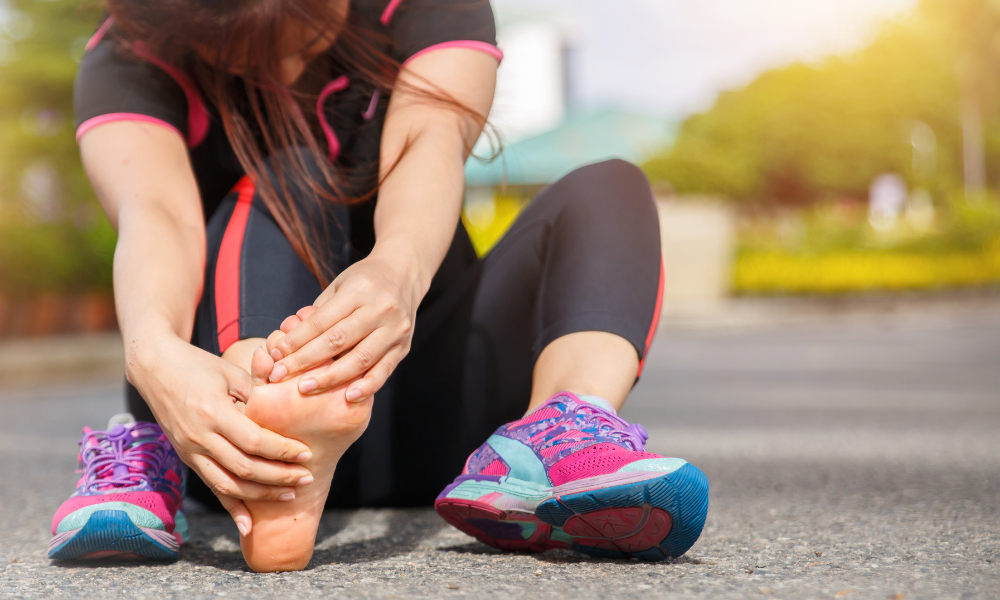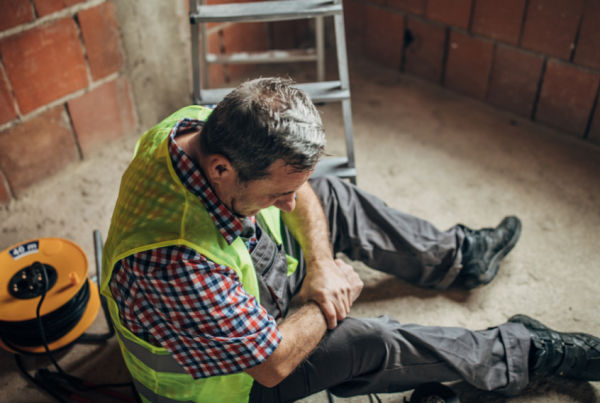Ankle, Foot, or Toe Pain
Move Better. Live Fuller. Your Wellness Journey Starts Here.
Schedule a FREE Discovery Call!
About Ankle, Foot, and Toe Pain
The ankles, feet, and toes all support your balance, stability, and movement. Each of these structures are used every day—sometimes all day long—to keep you steady and moving! They play important roles in your daily movement, but this also makes pain in the ankle, foot, or toe rather common.
Pain in these areas can affect your ability to walk and may cause you to overcompensate in other areas of the body. Putting weight on the affected side of your body may be difficult, and there may be other symptoms depending on the cause.
Some common causes of pain in your foot and nearby structures include injury, degenerative diseases, inflammation, and certain conditions.

These causes can create the following symptoms:
- Swelling and inflammation
- Stiffness and reduced range of motion
- Instability
- Bruising
- Pain that can be dull, sharp, or severe
- Burning sensations
- Tenderness
- Numbness or tingling
- And more
Thankfully, most causes of ankle, foot, and toe pain are able to be addressed or managed with physical therapy, as many of the causes are musculoskeletal. Let’s take a closer look at these causes next!
What Causes Ankle, Foot, or Toe Pain?
Pain in the ankle, foot, or toe can be caused by a wide variety of factors, some of which we’ll explore below:
Injuries
Injuries are a common cause of pain in any part of the ankles, feet, or toes. This is because the bones, muscles, and other tissues in these areas can be affected by things like impact, overuse, and overexertion. Some examples include:
- Fractures: Fractures can occur due to direct impact or stress on the ankles, feet, or toes. Fractures can create pain and instability, making it difficult or painful to walk.
- Sprains and strains: Injury of the muscles, tendons, or ligaments can occur in the ankles, feet, and even the toes. Sprains and strains can occur from a variety of impacts or sudden movements—such as twisting the ankle, overexertion while running or walking, or hitting your foot or toe against something.
- Achilles tendinitis: This is an injury specific to the ankle, as it affects the tendon that connects the calf to the heel bone. It often occurs to those who run or play sports, and may cause pain, stiffness, and difficulty with certain activities such as climbing stairs.
Conditions
Some conditions can contribute to or cause pain in the feet, ankles, or toes. This involves conditions of the joints, nerves, and other structures. Here are some examples:
- Osteoarthritis: A form of arthritis that involves the wearing away of cartilage, which is an important cushioning structure found in joints. Osteoarthritis can affect the ankle and toe joints, usually causing stiffness and pain.
- Rheumatoid arthritis: An autoimmune disease that creates joint inflammation and pain. This condition may also cause inflammation and swelling.
- Gout: Another type of arthritis that causes sudden “attacks” involving intense pain and inflammation. It is caused by the accumulation of urate crystals in the joints. These crystals occur when there is too much uric acid in the body.
- Neuromas: When the nerves that are part of the ankles or feet become irritated or compressed, it can create sharp pain, numbness, and tingling. In some cases, the response may be for surrounding tissue to thicken, causing what’s called a neuroma. It can make your foot or toes feel pain or numbness.
- Tarsal tunnel syndrome: A type of nerve compression in the ankle that can cause sudden pain as well as numbness or tingling.
- Plantar fasciitis: A common cause of heel pain due to inflammation of the plantar fascia, which is a band of tissue located across the bottom of your foot.
- Bunions: A bony bump that forms at the joint of the big toe. This causes the big toe to turn towards the smaller toes, and for the joint to protrude outwards. Bunions can cause pain and discomfort, and are often caused by a variety of factors such as tight footwear, foot structure, and genetic predisposition.
- Flat feet: This condition causes the arches of the feet to fall or flatten with pressure (such as while standing). Flat feet can cause foot and ankle pain that worsens with activity.
- Hammertoe: A deformity of one of the middle toes that causes it to sharply curve downward. This condition can cause swelling, difficulty walking, and pain.
- Turf toe: A condition of the joint located in the big toe. This condition involves the stretching or tearing of the tendons or ligaments of this joint, usually caused by jumping or running. It is common with athletes and can create pain, reduced range of motion, and swelling.
- Metatarsalgia: Sharp or burning pain located in the ball of the foot. It is frequently caused by ill-fitting shoes, physical activity, or foot deformities.
Lifestyle and Posture
Many causes of ankle, foot, and toe pain directly involve lifestyle choices such as posture, physical activity, and even the type of shoes you wear. Prolonged standing, tight shoes, and vigorous physical activity (exercise or sports) can cause damage or injury to your ankle, feet, or toes. In some cases, this can be an immediate injury—such as stubbing your toe—or an injury that builds slowly over time, such as from wearing tight shoes for many years.
For example, having poor posture that unevenly distributes weight can cause pain in the ankles and feet. This can include slouching, leaning forward, and even just general misalignment of the spine, hips, or pelvis. In other cases, playing sports that involve running, jumping, and changing positions quickly puts you at higher risk of ankle, foot, or toe injury. This is especially so if you do not practice good form or warm up your body properly before activity.
Physical Therapy for Ankle, Foot, and Toe Pain
Physical therapy treatment for problems with the ankles, feet, or toes may depend on your individual situation and medical history. Therefore, your physical therapist will perform a thorough evaluation, which can include the following:
- A discussion of your medical history and conditions that may contribute to your pain.
- Providing details about any previous surgeries or injuries relevant to your pain.
- Providing details about your symptoms, such as the intensity, duration, or frequency of your pain.
- A physical examination of your condition.
During the physical examination, your physical therapist will check for swelling, redness, bruising, or tenderness. They may examine your gait, posture, range of motion, and muscle balance. Depending on the severity of your condition, they may have you perform movements or activities to test the strength and function of the affected area.
Once they have a better understanding of your condition, pain, and possible causes of your symptoms, they’ll create a comprehensive treatment plan that is curated to your needs. This will include a variety of treatments to relieve your pain, restore your function, and get you back to moving comfortably!
This can include treatments such the following:
Neuromuscular Re-education and Biofeedback
These treatments will help restore your function and coordination, which will allow you to regain normal movement after injury or surgery.
Manual Therapy
Manual techniques can be used throughout your healing journey to relieve pain, improve muscle function and blood flow, and even address scar tissue. Manual therapy can include hands-on tissue manipulation, dry needling, tissue scraping, cupping, and more.
Exercise and Strengthening
Depending on the severity and duration of your pain, it is possible that you have muscle imbalances due to long-term overcompensation—in other words, you may have put pressure on other parts of your body while trying to avoid pain in one foot, ankle, or toe. Your physical therapist will develop a curated exercise plan to reduce muscle dysfunction or weakness, and restore muscle coordination for the whole body.
Correcting Your Posture and Gait
Similarly, your posture and walking patterns may have been altered by your injury or could have even been a cause of your pain. Your physical therapist will be sure to address any postural imbalances and will correct your walking patterns to reduce pressure or strain on your affected limb.
There are many different ways that a physical therapist can address pain in your feet, ankles, or toes—some of which we didn’t go into full detail here. Regardless, the providers at Hive Therapy and Wellness always create a thorough and holistic treatment plan for each and every patient, as each patient’s needs are different. To achieve this, they’ll use a variety of treatment methods, which may include any of the following:
- Neuromuscular re-education
- Manual therapy
- Exercise prescription
- Dry needling
- Cupping
- Tissue scraping
- Behavioral modifications
- Therapeutic activities
- Electrical muscle stimulation
- Spinal manipulation
- Therapeutic modalities
- Biofeedback
The ankles, feet, and toes all support your balance, stability, and movement. Each of these structures are used every day—sometimes all day long—to keep you steady and moving!
They play important roles in your daily movement, but this also makes pain in the ankle, foot, or toe rather common.
Pain in these areas can affect your ability to walk and may cause you to overcompensate in other areas of the body. Putting weight on the affected side of your body may be difficult, and there may be other symptoms depending on the cause.
Some common causes of pain in your foot and nearby structures include injury, degenerative diseases, inflammation, and certain conditions. These causes can create the following symptoms:
- Swelling and inflammation
- Stiffness and reduced range of motion
- Instability
- Bruising
- Pain that can be dull, sharp, or severe
- Burning sensations
- Tenderness
- Numbness or tingling
- And more
Thankfully, most causes of ankle, foot, and toe pain are able to be addressed or managed with physical therapy, as many of the causes are musculoskeletal. Let’s take a closer look at these causes next!
Pain in the ankle, foot, or toe can be caused by a wide variety of factors, some of which we’ll explore below:
Injuries
Injuries are a common cause of pain in any part of the ankles, feet, or toes. This is because the bones, muscles, and other tissues in these areas can be affected by things like impact, overuse, and overexertion. Some examples include:
Fractures: Fractures can occur due to direct impact or stress on the ankles, feet, or toes. Fractures can create pain and instability, making it difficult or painful to walk.
Sprains and strains: Injury of the muscles, tendons, or ligaments can occur in the ankles, feet, and even the toes.
Sprains and strains can occur from a variety of impacts or sudden movements—such as twisting the ankle, overexertion while running or walking, or hitting your foot or toe against something.
Achilles tendinitis: This is an injury specific to the ankle, as it affects the tendon that connects the calf to the heel bone. It often occurs to those who run or play sports, and may cause pain, stiffness, and difficulty with certain activities such as climbing stairs.
Conditions
Some conditions can contribute to or cause pain in the feet, ankles, or toes. This involves conditions of the joints, nerves, and other structures. Here are some examples:
Osteoarthritis: A form of arthritis that involves the wearing away of cartilage, which is an important cushioning structure found in joints. Osteoarthritis can affect the ankle and toe joints, usually causing stiffness and pain.
Rheumatoid arthritis: An autoimmune disease that creates joint inflammation and pain. This condition may also cause inflammation and swelling.
Gout: Another type of arthritis that causes sudden “attacks” involving intense pain and inflammation. It is caused by the accumulation of urate crystals in the joints. These crystals occur when there is too much uric acid in the body.
Neuromas: When the nerves that are part of the ankles or feet become irritated or compressed, it can create sharp pain, numbness, and tingling.
In some cases, the response may be for surrounding tissue to thicken, causing what’s called a neuroma. It can make your foot or toes feel pain or numbness.
Tarsal tunnel syndrome: A type of nerve compression in the ankle that can cause sudden pain as well as numbness or tingling.
Plantar fasciitis: A common cause of heel pain due to inflammation of the plantar fascia, which is a band of tissue located across the bottom of your foot.
Bunions: A bony bump that forms at the joint of the big toe. This causes the big toe to turn towards the smaller toes, and for the joint to protrude outwards.
Bunions can cause pain and discomfort, and are often caused by a variety of factors such as tight footwear, foot structure, and genetic predisposition.
Flat feet: This condition causes the arches of the feet to fall or flatten with pressure (such as while standing). Flat feet can cause foot and ankle pain that worsens with activity.
Hammertoe: A deformity of one of the middle toes that causes it to sharply curve downward. This condition can cause swelling, difficulty walking, and pain.
Turf toe: A condition of the joint located in the big toe. This condition involves the stretching or tearing of the tendons or ligaments of this joint, usually caused by jumping or running.
It is common with athletes and can create pain, reduced range of motion, and swelling.
Metatarsalgia: Sharp or burning pain located in the ball of the foot. It is frequently caused by ill-fitting shoes, physical activity, or foot deformities.
Lifestyle and Posture
Many causes of ankle, foot, and toe pain directly involve lifestyle choices such as posture, physical activity, and even the type of shoes you wear.
Prolonged standing, tight shoes, and vigorous physical activity (exercise or sports) can cause damage or injury to your ankle, feet, or toes.
In some cases, this can be an immediate injury—such as stubbing your toe—or an injury that builds slowly over time, such as from wearing tight shoes for many years.
For example, having poor posture that unevenly distributes weight can cause pain in the ankles and feet. This can include slouching, leaning forward, and even just general misalignment of the spine, hips, or pelvis.
In other cases, playing sports that involve running, jumping, and changing positions quickly puts you at higher risk of ankle, foot, or toe injury. This is especially so if you do not practice good form or warm up your body properly before activity.
Physical therapy treatment for problems with the ankles, feet, or toes may depend on your individual situation and medical history. Therefore, your physical therapist will perform a thorough evaluation, which can include the following:
- A discussion of your medical history and conditions that may contribute to your pain.
- Providing details about any previous surgeries or injuries relevant to your pain.
- Providing details about your symptoms, such as the intensity, duration, or frequency of your pain.
- A physical examination of your condition.
During the physical examination, your physical therapist will check for swelling, redness, bruising, or tenderness.
They may examine your gait, posture, range of motion, and muscle balance. Depending on the severity of your condition, they may have you perform movements or activities to test the strength and function of the affected area.
Once they have a better understanding of your condition, pain, and possible causes of your symptoms, they’ll create a comprehensive treatment plan that is curated to your needs.
This will include a variety of treatments to relieve your pain, restore your function, and get you back to moving comfortably!
This can include treatments such the following:
Neuromuscular Re-education and Biofeedback
These treatments will help restore your function and coordination, which will allow you to regain normal movement after injury or surgery.
Manual Therapy
Manual techniques can be used throughout your healing journey to relieve pain, improve muscle function and blood flow, and even address scar tissue.
Manual therapy can include hands-on tissue manipulation, dry needling, tissue scraping, cupping, and more.
Exercise and Strengthening
Depending on the severity and duration of your pain, it is possible that you have muscle imbalances due to long-term overcompensation—in other words, you may have put pressure on other parts of your body while trying to avoid pain in one foot, ankle, or toe.
Your physical therapist will develop a curated exercise plan to reduce muscle dysfunction or weakness, and restore muscle coordination for the whole body.
Correcting Your Posture and Gait
Similarly, your posture and walking patterns may have been altered by your injury or could have even been a cause of your pain.
Your physical therapist will be sure to address any postural imbalances and will correct your walking patterns to reduce pressure or strain on your affected limb.
There are many different ways that a physical therapist can address pain in your feet, ankles, or toes—some of which we didn’t go into full detail here.
Regardless, the providers at Hive Therapy and Wellness always create a thorough and holistic treatment plan for each and every patient, as each patient’s needs are different.
To achieve this, they’ll use a variety of treatment methods, which may include any of the following:
- Neuromuscular re-education
- Manual therapy
- Exercise prescription
- Dry needling
- Cupping
- Tissue scraping
- Behavioral modifications
- Therapeutic activities
- Electrical muscle stimulation
- Spinal manipulation
- Therapeutic modalities
- Biofeedback
You can learn more about these treatments on our Treatments Page.





